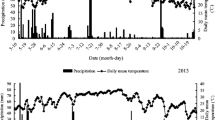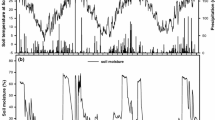Abstract
Field measurements of CH4 emission from rice paddy field during cultivation periods were performed at all of 47 Japanese prefectures under the project of ‘Research for evaluation of CH4 and N2O emissions from agricultural land, and improvement methods of soil, water and fertilizer management’ conducted by Agricultural Production Bureau, the Ministry of Agriculture, Forestry and Fisheries. Although this project was carried out at 159 fields, the data of 132 fields were used for this report because other 27 fields had not enough data to be suitable for the statistics analyses.
The measurements at rice paddy fields in various locations in Japan showed that there were large temporal variations of CH4 flux and that the fluxes differed markedly with climate, characteristics of soil and paddy, application of organic matter and mineral fertilizer, and agricultural management practices.
These data mainly indicated that CH4 emission from Gley soils was greater than those from other soil types such as Andosols, Upland soils, fine-textured Lowland soils, medium and coarse-textured Lowlands soils and gravelly Lowland soils, and that water and organic matter managements influenced CH4 emission. It is suggested that midsummer drainage treatment suppressed while the application of fresh organic matter such as rice straw and wheat straw enhanced CH4 emission, respectively.
Similar content being viewed by others
References
Climate Change 1994 (1995) Intergovernmental Panel on Climate Change, pp 7–34. Cambridge Univ. Press, Cambridge, UK
Minami K & Yagi K (1988) Method for measuring methane flux from rice paddies. Jpn J Soil Sci Plant Nutr 59: 458–463 (In Japanese)
Minami K (1994) Methane emission from rice production. Fert Res 37: 167–179
Minami K, Mosier A & Sass R (eds) (1994) CH4 and N2O; Global Emissions and Controls from Rice Fields and Other Agricultural and Industrial Sources. Yokendo, Tokyo, Japan
Minami K (1995) The effect of nitrogen fertilizer use and other practices on methane emission from flooded rice. Fert Res 40: 71–84
Ministry of Agriculture, Forestry and Fisheries, Agricultural Production Bureau (1994) Meeting, Research for evaluation of CH4 and N2O emissions from agriculural land, and improvement methods of soil, water and fertilizer management. March 1995 (In Japanese)
Sass RL (1994) Sort summary chapter for methane. In: Minami K, Mosier A & Sass R (eds) CH4 and N2O; Global Emissions and Controls from Rice Fields and Other Agricultural and Industrial Sources, pp 1–7. Yokendo, Tokyo, Japan
Yagi K & Minami K (1990) Effect of organic matter application on methane emission from some Japanese paddy fields. Soil Sci Plant Nutr 36: 599–610
Yagi K, Minami K & Ogawa Y (1990) Effects of water percolation on methane emission from paddy fields. NIAES Res Rep Div Environ Planning 6: 105–112
Author information
Authors and Affiliations
Rights and permissions
About this article
Cite this article
Kanno, T., Miura, Y., Tsuruta, H. et al. Methane emission from rice paddy fields in all of Japanese prefecture. Nutrient Cycling in Agroecosystems 49, 147–151 (1997). https://doi.org/10.1023/A:1009778517545
Issue Date:
DOI: https://doi.org/10.1023/A:1009778517545




